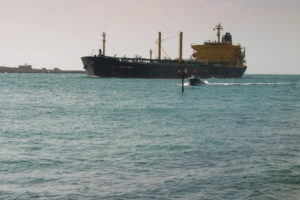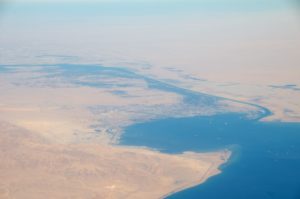In 2014, the expansion of Egypt’s Suez Canal was proposed as a way to attract more ships and boost international trade. Following extensive construction, the expanded Suez Canal debuted the following year. The New Suez Canal (NSC) project encompassed a massive seaport, fish farms, an industrial zone, and seven new tunnels between the three main ports—Sinai, Ismailia, and Port Said.
Sometimes known as “The Great Egyptian Dream,” the project was intended to boost Egypt’s economy and facilitate global exchange. While the project was heavily praised in the press after its inauguration in August 2015, questions have lingered about its value.
Expanded canal offers many benefits

Suez Canal | Image by Brigitte Djajasasmita | Flickr
The NSC added a 22-mile long second shipping lane to the existing canal, which was originally built in 1869 as a shortcut for ships traveling between Asia and Europe, and created a way for cargo ships to pass one another while traveling in opposite directions. Prior to the start of construction, the canal was 23 miles long, which meant that its expansion would provide freedom of movement throughout nearly its entire length. Not only did expanded canal reduce the waiting time from 11 to 3 hours, but it allowed up to 48 more ships to pass through the canal each day.
The new canal has improved traffic control, reduced trip times, and fostered growth in the area, making it the route of choice for ship owners around the world. In addition, it has boosted the national income by providing needed jobs and creating opportunities for those in the surrounding communities. While the expanded canal has provided many benefits, the government, financial analysts, and scientists are still pondering the $8.2 billion price tag, along with some associated risks and problems.
Costs draw scrutiny
Despite promises that it would double annual revenues to almost $13.5 billion by 2023 and accrue yearly growth of about 10 percent, a recent report from the International Monetary Fund suggests there has actually been a reduction in the total NSC revenue by about 10 percent, or $150 million.
Although the project was originally supposed to be financed through a stock market IPO, which would have allowed private ownership, the financing strategy relied on interest-bearing investment certificates instead. This meant investors had no ownership rights to the project.
Analysts have since pointed out how the volume of trade has not reached the projected levels, despite the money and effort invested in it. Egyptians appear to be divided on the subject, with much of the population wondering whether the price tag was worth the results. Some believe that the money would have been better spent on improving infrastructure and public services, thereby helping more people.
Some economists believe that the government should have conducted a viability study to tally the immediate benefits of such an undertaking. However, pro-government outlets have hailed the project as a national triumph, despite its cost, and viewed it as a turning point for a country mired in years of instability.
Environmental concerns

Suez Canal | Image by David Reid | Flickr
In 2014, several biologists expressed concerns about how the expansion would affect the biodiversity and larger ecosystems in the area. Since the canal was originally built, over 1,000 invasive species have entered the Mediterranean Sea through the Suez Canal. This type of invasion from the Red Sea can result in a wide range of negative effects on both humans and the environment, including the introduction of poisonous or venomous species such as the devil firefish. This has led scientists to wonder what would happen if the site was expanded without consideration for marine life or how increased human activity would affect the landscape.
Scientists asked Egyptian officials to conduct an independent Environmental Impact Assessment before moving forward in order to predict problems and assume preventative measures. They believe that any dismissal of their concerns could create a threat to agriculture, tourism, fisheries, and other areas. When the Suez Canal Authority submitted an Environmental Impact Assessment study of the project in 2014, a decision was made to pay close attention to minimizing any negative impact during the constructions phase and to ensure the proper disposal of dredging waste and hazardous substances such as oil and grease.
While the commercial appeal of the project was clear, scientists were less than enthusiastic about the threat of harm to the area. However, despite these warnings, work on the new canal was rushed through without a full study on its ecological impact, and the project was ultimately completed in just one year. Even though the Egyptian Ministry of the Environment claims that it provided its own—albeit unpublished—Environmental Impact Assessment study, scientists say that no proper assessment was ever carried out.

